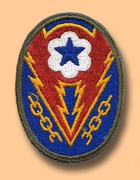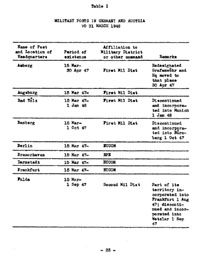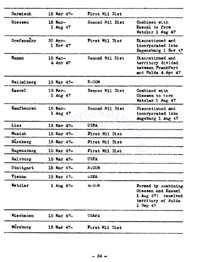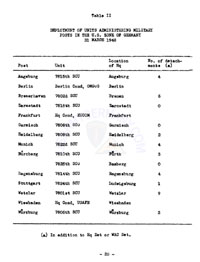Military
Posts
European Command
Looking for more information from military/civilian
personnel assigned to or associated with the U.S. Army
in Germany from 1945 to 1989. If you have any
stories or thoughts on the subject, please email me (webmaster).
|
|
|
|
|
| |
| Establishment
of Military Posts |
| |
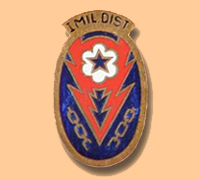 1st Military District DUI 1st Military District DUI
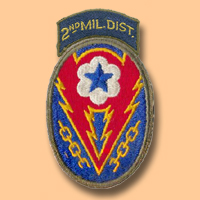 2nd Military District Patch w/ Tab (can anybody confirm accuracy?) 2nd Military District Patch w/ Tab (can anybody confirm accuracy?) |
| |
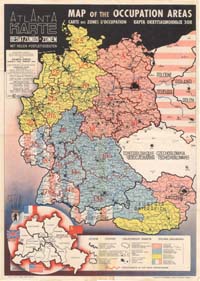 Click on
map to view map of Landkreise of the US Zone of Occupation
Click on
map to view map of Landkreise of the US Zone of Occupation
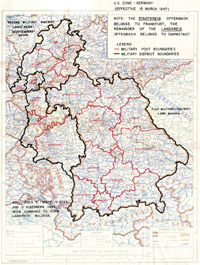 Click on
map to view USFET Military Posts (US Zone only) Click on
map to view USFET Military Posts (US Zone only) |
| (Source: Letter,
USFET, 21 February 1947, file AG 322 GCT-AGO, subj: Military Posts) |
1. Effective
15 March 1947 all previous designations of military communities and
their satellites and boundaries are rescinded.
2. Effective 15 March 1947 the following military posts are established: |
|
a. |
Under the
Headquarters, US Constabulary with post headquarters
as indicated: |
|
|
(1) |
The
Kassel military post with headquarters at Kassel to consist
of the Landkreis Hofgeismar, Kassel, Wolfhagen, Waldeck, Witzenhausen,
Melsungen, Frankenberg, Fritzlar-Homberg, Eschwege and Ziegenhain. |
|
(2) |
The
Giessen military post with headquarters at Giessen to
consist of the Landkreis Biedenkopf, Marburg, Alsfeld, Dillkreis,
Wetzlar, Giessen and Oberlahnkreis. |
|
(3) |
The
Fulda military post with headquarters at Fulda to consist
of the Landkreis Rotenburg, Hersfeld, Hünfeld, Lauterbach
and Fulda. |
|
(4) |
The
Hanau military post with headquarters at Hanau to consist
of the Landkreis Büdingen, Gelnhausen, Schlüchtern
and Hanau. |
|
(5) |
The
Darmstadt military post with headquarters at Darmstadt
to consist of the Landkreis Gross-Gerau, Offenbach (less the
town of Offenbach), Darmstadt, Dieburg, Bergstrasse, Erbach
and that portion of Worms lying east of the Rhine River. |
|
(6) |
The
Heidelberg military post is established with headquarters
at Heidelberg to consist of the Landkreis Mannheim, Heidelberg,
Mosbach, Buchen, Tauberbischofsheim, Bruchsal, Sinsheim, Karlsruhe
and Pforzheim. |
|
(7) |
The
Stuttgart military post is established with headquarters
at Stuttgart to consist of the Landkreis Mergentheim, Künzelsau,
Heilbronn, Öhringen, Crailsheim, Hall, Vaihingen, Ludwigsburg,
Backnang, Aalen, Leonberg, Esslingen, Stuttgart, Waiblingen,
Gmünd, Böblingen, Nürtingen, Göppingen,
Heidenheim and Ulm. |
|
|
b. |
The Frankfurt
military post as established under Headquarters Command,
US Forces, European Theater, with headquarters at Frankfurt
will consist of the Landkreis Usingen, Friedberg, Obertaunus,
Maintaunus, Stadtkreis Frankfurt and Stadtkreis Offenbach. |
|
|
c. |
The Wiesbaden
military post established under command of US Air Forces
in Europe with headquarters at Wiesbaden to consist of the Landkreis
Limburg, Untertaunus, Rheingau, Wiesbaden and that portion of
Mainz east of the Rhine River. |
|
d. |
Under the
First Military District (Land Bavaria) with post headquarters
as indicated: |
|
|
(1) |
The
Würzburg military post with headquarters at Würzburg
to consist of the Landkreis Mellrichstadt, Neustadt, Brückenau,
Kissingen, Königshofen, Gemünden, Hammelburg, Schweinfurt,
Hofheim, Ebern, Hassfurt, Alzenau, Lohr, Karlstadt, Gerolzhofen,
Aschaffenburg, Marktheidenfeld, Würzburg, Kitzingen, Obernburg,
Miltenberg and Ochsenfurt. |
|
(2) |
The
Bamberg military post with headquarters at Bamberg to
consist of the Landkreis Coburg, Kronach, Naila, Hof, Rehau,
Lichtenfels, Stadtsteinach, Münchberg, Wunsiedel, Kulmbach,
Bamberg, Ebermannstadt, Bayreuth, Pegnitz and Staffelstein. |
|
(3) |
The
Nürnberg-Fürth military post with headquarters
at Nürnberg to consist of the Landkreis Scheinfeld, Höchstadt,
Forchheim, Uffenheim, Neustadt, Fürth, Erlangen, Lauf,
Hersbruck, Nürnberg, Rothenburg, Ansbach, Schwabach, Hilpoltstein,
Feuchtwangen, Gunzenhausen, Weissenburg, Eichstätt and
Dinkelsbühl. |
|
(4) |
The
Amberg military post with headquarters at Amberg to consist
of the Landkreis Kemnath, Tirschenreuth, Eschenbach, Neustadt,
Vohenstrauss, Sulzbach-Rosenberg, Amberg, Nabburg, Oberviechtach,
Neunburg, Waldmünchen and Neumarkt. |
|
(5) |
The
Regensburg military post with headquarters at Regensburg
to consist of the Landkreis Beilngries, Parsberg, Burglengenfeld,
Roding, Cham, Kötzting, Riedenburg, Kelheim, Regensburg,
Bogen, Viechtach, Regen, Mallersdorf, Straubing, Deggendorf,
Grafenau, Wolfstein, Mainburg, Rottenburg, Landshut, Dingolfing,
Landau, Vilshofen, Passau, Wegscheid, Vilsbiburg, Eggenfelden,
Pfarrkirchen and Griesbach. |
|
(6) |
The
Augsburg military post is established with headquarters
at Augsburg to consist of the Landkreis Nördlingen, Donauwörth,
Neuburg, Dillingen, Wertingen, Aichach, Schrobenhausen, Günzburg,
Augsburg, Friedberg, Neu-Ulm, Krumbach, Schwabmünchen and
Landsberg. |
|
(7) |
The
München (Munich) military post is established with
headquarters at München to consist of the Landkreis Ingolstadt,
Pfaffenhofen, Freising, Dachau, Erding, Fürstenfeldbruck,
Starnberg, München, Ebersberg and Wolfratshausen. |
| |
(8) |
The
Kaufbeuren military post is established with headquarters
at Kaufbeuren to consist of the Landkreis Illertissen, Mindelheim,
Memmingen, Kaufbeuren, Kempten, Marktoberdorf, Füssen and
Sonthofen. |
| |
(9) |
The
Garmisch military post is established with headquarters
at Garmisch to consist of the Landkreis Schongau, Weilheim and
Garmisch-Partenkirchen. |
| |
(10) |
The
Bad Tölz military post is established with headquarters
at Bad Tölz to consist of the Landkreis Tölz, Miesbach,
Aibling, Rosenheim, Wasserburg, Mühldorf, Altötting,
Traunstein, Laufen and Berchtesgaden. |
|
|
e. |
Inclosure
1 accompanying this directive is a map (Webmaster Note:
my copy of the source does not include a copy of the map mentioned
in this paragraph, but I will create a similar one and add it
to this page) of the US Zone with the boundaries of the military
posts. Designation on the inclosed map of the First and Second
Military Districts and the boundary between the First and Second
Military District (Land Hessen and Land Wurttemberg-Baden) should
be deleted. This combined area is designated the Second Military
District. The Headquarters, US Constabulary is designated as
the agency for the command and administration of the Second
Military District. Designation of the Third Military District
is changed to First Military District; the boundary remains
as indicated on the inclosed map. |
|
| 3. |
a. |
The hereinafter
listed installations and towns located within the indicated
military posts are designated as Air Force exempt installations
and will be administered and supported by the US Air Forces
in Europe in accordance with letter, this headquarters, file
as above, subject: "Organization, Command and Administration
of Military Districts in the US Zone of Germany and the Bremen
Enclave," 31 January 1947 and letter, this headquarters,
file as above, subject: "Organization, Command and Administration
of Military Posts in Germany," 31 January 1947. (See inclosure
2, which is a set of maps showing exact location and boundaries
of the Air Force exempt installations.)(Webmaster Note:
not included in source.) |
|
|
(1) |
Exempt
Air Force installations are established within the Würzburg
military post consisting of the Bad Kissingen Air Base,
the area within the town limits of Bad Kissingen, Hausen, Winkels,
Garitz, Bad Naustadt; the Schweinfurt Air Base and the
area within the town limits of Schweinfurt; the Kitzingen
Air Base and the area within the town limits of Kitzingen;
the Giebelstadt Air Base and the area within the town
limits of Giebelstadt. |
|
(2) |
Exempt
Air Force installations are established within the Nürnberg-Fürth
military post consisting of the Ansbach Air Depot
and the area within the town limits of Katterbach, Obereichenbach
and Ansbach; the Fürth Air Base; the Industriehafen
Air Base; the Bruck Air Ordnance Depot including
the area within the town limits of Bruck and Eltersdorf; the
Erlangen Air Base including the area within the town
limits of Erlangen; the Caserne area including the area
within the town limits of Uttenreut, occupied by the 22nd Motor
Transport Squadron, and Forchheim; the Roth Air Ammunition
Depot including the area within the town limits of Roth
and Hilpoltstein. |
|
(3) |
Exempt
Air Force installations are established within the Regensburg
military post consisting of the Straubing Air Base
and the area within the town limits of Straubing; the Puchhof
Castle located in the village of Puchhof. |
|
(4) |
Exempt
Air Force installations are established within the Munich
military post consisting of the Munich Air Base including
the area within the town limits of Neuramersdorf and Unterhaching;
the Neubiberg Air Base including the area within the
town limits of Neubiberg, Ottobrunn and Waldperlach; the Erding
Air Depot including the area within the town limits of Langengeisling,
Erding, Notzing, Moosburg and Schleissheim; the Oberweissenfeld
(sic) Air Base; the Fürstenfeldbruck Air
Base including the area within the town limits of Fürstenfeldbruck
and Maisach; the Oberpfaffenhofen Air Base including
the area within the town limits of Oberpfaffenhofen, Argelsried,
Herrsching, Hechendorf, Steinebach, Walchstadt, Gauting, Krailling,
Stockdorf, Weßling and Starnberg. A rest center operated
by the First Military District is currently established at Starnberg.
No change in assignment of facilities currently used by this
rest center will be made except after full coordination between
US Air Forces in Europe and the Commanding General, First Military
District. |
|
(5) |
Exempt
Air Force installations are established within the Darmstadt
military post consisting of the Rhine/Main Air Field;
the Zeppelinheim Air Ammunition Depot; the area of Camp
Kelsterbach; the area within the town limits of Neu-Isenburg,
Buchschlag, Walldorf, Mörfelden and Kelsterbach; the Eschborn
Air Field and in Bad Soden, the Europasiahof Hotel
only. |
|
(6) |
Exempt
Air Force installations are established within the Augsburg
military post consisting of the Landsberg Air Base
including the areas within the town limits of Landsberg and
of Penzing; the Landsberg Air Ammunition Depot including
the area within the town limits Landsberg and Böblingen;
the Lechfeld Air Base including the areas within the
town limits of Klosterlechfeld and Schwabstadl and the area
within the town limits of Schwabmünchen and Untermeitingen. |
|
(7) |
Exempt
Air Force installations are established within the Kassel
military post consisting of the Fritzlar Air Base
including the area within the town limits of Fritzlar, Gudensberg,
Wabern, Bad Wildungen and Homberg. |
| |
(8) |
Within
the area of the Bad Tölz military post the Air Force
will continue to operate the Air Force Rest Center at Bad Wiessee,
Tegernsee, Rottach, Kreuth, Kochel, Badersee (sic) and Ober
Grainau. The buildings and facilities currently utilized by
the Air Force in the operation of this Rest Center will not
be reassigned without complete coordination between the Commanding
Generals, US Air Forces in Europe and the First Military District. |
| |
(9) |
The
term "Exempt Air Force Installations" as applied to
Caserne area including the area within the town lomits of Uttenreut
(subparagraph 2), the Puchhof Castle in the village of Puchhof
(subparagraph 3) and the Europasia Hotel in Bad Soden (subparagraph
5) will be construed to reserve these installations for Air
Force use until such time as no longer needed, at which time
they will be returned to control of the appropriate ground force
headquarters.. |
|
| |
BY COMMAND OF
GENERAL McNARNEY:
PETER CALZAN
Lt Col, AGD
Assistant Adjutant General |
|
| (Source: Vol V, The 1st Quarter, The Third Year of the Occupation, OCCUPATION FORCES Series, HQ EUCOM, 1948) |
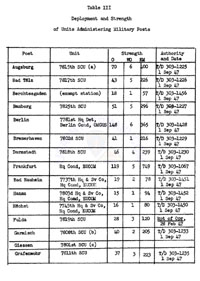 Military Posts, Sept 1947
Military Posts, Sept 1947 |
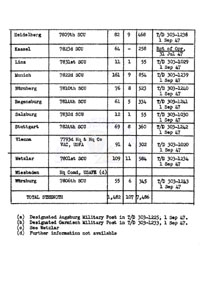
Military Posts, Sept 1947 #2
|
|
|
|
|
| (Source: Vol V, The 3rd Quarter, The Third Year of the Occupation, OCCUPATION FORCES Series, HQ EUCOM, 1948) |
|
|
|
|
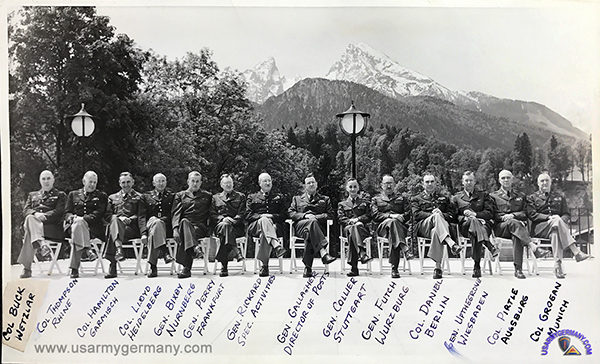
Military Post Commanders pose for a group photo on the terrace of the Hotel
Berchtesgadener Hof in Berchtesgaden in May 1951 (Gen Gallagher collection) |
| |
| (Source: Vol V, The Fourth Year of the Occupation, OCCUPATION FORCES Series, HQ EUCOM, 1949) |
| (Reporting Period: 1 July - 31 Dec 1948)
1. The Office of the Director of Posts
 a. Organisation and Personnel a. Organisation and Personnel
By order of the Deputy Commander in Chief, EUCOM, the Office of the Director of Posts was established on 15 June 1948 as the sixth general staff division in EUCOM Headquarters. The establishment of the Division became necessary as a result of the inactivation earlier in the year of the First and Second Military Districts, formerly responsible for the supervision of military posts. The office consisted only of the Director, together with his executive and administrative officers. Brig. Gen. P.E. Gallagher served as Chief of the Division, and 1st Lt. L.W. Howe served as executive officer until replaced by 1st Lt. Thomas L. Stafford at the end of the period. CWO N.J. Hromadka joined the Division as Administrative Officer in September.
 b. Mission b. Mission
 (1) Inspection of Posts. The Director of the Military Posts Division was responsible for inspecting all military posts and installations under the jurisdiction of the Commanding General, U.S. Army, Europe to insure the proper execution of Army policies and procedures throughout the Command, and to improve and unify administrative standards. Although the formulation of policies and directives was not a function of the Division, the Director brought to the attention of the appropriate general or special staff division any recommended changes in policy. In performing inspections, the Director was authorised the use, on a part-time basis, of personnel assigned to other staff divisions of EUCOM Headquarters. The results of inspections were brought to the attention of the Commanding General, USAREUR, at personal conferences, rather than through detailed and voluminous reports. Short random notes were submitted by members of inspection teams to the Director, Military Posts Division, for review, and if further action was required at the EUCOM staff level to correct deficiencies, extracts were furnished to the appropriate staff divisions for action. Finally, complete notes on inspections were forwarded by cover letter from the Director, Military Posts Division, to the post commanders of the military posts inspected, for the correction of deficiencies, (1) Inspection of Posts. The Director of the Military Posts Division was responsible for inspecting all military posts and installations under the jurisdiction of the Commanding General, U.S. Army, Europe to insure the proper execution of Army policies and procedures throughout the Command, and to improve and unify administrative standards. Although the formulation of policies and directives was not a function of the Division, the Director brought to the attention of the appropriate general or special staff division any recommended changes in policy. In performing inspections, the Director was authorised the use, on a part-time basis, of personnel assigned to other staff divisions of EUCOM Headquarters. The results of inspections were brought to the attention of the Commanding General, USAREUR, at personal conferences, rather than through detailed and voluminous reports. Short random notes were submitted by members of inspection teams to the Director, Military Posts Division, for review, and if further action was required at the EUCOM staff level to correct deficiencies, extracts were furnished to the appropriate staff divisions for action. Finally, complete notes on inspections were forwarded by cover letter from the Director, Military Posts Division, to the post commanders of the military posts inspected, for the correction of deficiencies,
 (2) DCinC's Monthly Conferences. The Military Posts Division was responsible for the Deputy Commander in Chief's monthly conferences with all military post commanders, held each month in the Command Building at Heidelberg. Heads of all EUCOM staff divisions having interest in the conferences attended to discuss policies and procedures with the post commanders, and to effect uniform and improved standards of administration throughout the European Command. The military Posts Division was charged with administrative matters pertaining to the conferences and with setting the agenda for the Commanding General, USAREUR, after consultations with general and special staff divisions. Briefs of all staff divisions rare consolidated for presentation at the conference, and all notes or discussions were limited to material to be discussed at the conference. (2) DCinC's Monthly Conferences. The Military Posts Division was responsible for the Deputy Commander in Chief's monthly conferences with all military post commanders, held each month in the Command Building at Heidelberg. Heads of all EUCOM staff divisions having interest in the conferences attended to discuss policies and procedures with the post commanders, and to effect uniform and improved standards of administration throughout the European Command. The military Posts Division was charged with administrative matters pertaining to the conferences and with setting the agenda for the Commanding General, USAREUR, after consultations with general and special staff divisions. Briefs of all staff divisions rare consolidated for presentation at the conference, and all notes or discussions were limited to material to be discussed at the conference.
 (3) "Little Post Commanders' Meeting." In addition, a "Little Post Commanders' Meeting," initiated at the direction of the Chief of Staff, was conducted each month at one of the military post headquarters. The meeting, attended by all post commanders, was presided over by the Director, Military Posts Division, and was devoted to discussions of problems pertaining to S - 1, S - 2, S - 3, S - 4, and other sections. The problems and suggested solutions were in turn presented by the Director, Military Posts Division, to the Commanding General, USAREUR, and to the appropriate general and special staff divisions. (3) "Little Post Commanders' Meeting." In addition, a "Little Post Commanders' Meeting," initiated at the direction of the Chief of Staff, was conducted each month at one of the military post headquarters. The meeting, attended by all post commanders, was presided over by the Director, Military Posts Division, and was devoted to discussions of problems pertaining to S - 1, S - 2, S - 3, S - 4, and other sections. The problems and suggested solutions were in turn presented by the Director, Military Posts Division, to the Commanding General, USAREUR, and to the appropriate general and special staff divisions.
2. Posts Supervised
During the period under review the number of military posts decreased, with the discontinuance of the Regensburg Post, from thirteen to twelve. At the end of December the Military Post Division was providing Command supervision for the following posts: Augsburg, Berlin, Bremerhaven, Frankfurt, Garmisch, Heidelberg, Munich, Nürnberg, Stuttgart, Wetzlar, and Würzburg. The Director of Posts did not inspect the Wiesbaden Military Post, which was not a major command, but reported administratively to Command Headquarters through USAFE. Table 1 gives a complete list of posts and sub-posts and the names of their respective commanders as of 15 July and 31 December 1940. Berlin, Bremerhaven, and Wiesbaden were the only military posts having no sub-posts.
|
|
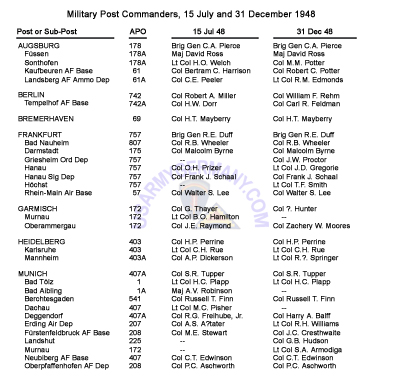
Military Post Commanders, late 1948 (Page 1, 2) |
|
3. Administrative Changes
 a. Merger of Posts a. Merger of Posts
To conserve manpower and supplies, the Darmstadt Post was made a sub-post of the Frankfurt Military Post on 1 July. The 7818th Station Complement Unit which had administered the Darmstadt Post was discontinued and its personnel were transferred to the 7811th Station Complement Unit.
 b. Transfer to USAFE b. Transfer to USAFE
On 3 July the area within the town limits of Kempten and Mendelheim, in the Augsburg Military Post area was designated a part of the Kaufbeuren Air Base, an exempted air station. With this trasfer, the U.S. Air Forces in Europe became responsible for the administration and logistical support of units stationed in Kempten and Mendelheim.
 c. Transfer of Kreis Weilheim c. Transfer of Kreis Weilheim
On 15 August the district of Weilheim in Bavaria, including the EUCOM Engineer School at Weilheim, was transferred from Garmisch Military Post to the Munich Military Post. The Commanding Officer, Munich Military Post, acquired general court-martial jurisdiction over all persons subject to military law in Weilheim except those serving with the U.S. Air Forces in Europe, the U.S. Constabulary, or the 1st Infantry Division.
 d. Discontinuance of Regensburg Military Post d. Discontinuance of Regensburg Military Post
The discontinuance of the Regenshurg Military Post, announced on 20 August, became effective on 1 November. The 7814th Station Complement Unit, which had administered the Regensburg Post, was discontinued, and the area formerly assigned to the Post was divided between the Military Posts of Nürnberg-Fürth and Munich. Although EUCOM Headquarters granted increased allocations of personnel and equipment to the Munich and Nürnberg-Fürth Posts to enable them to fulfill their additional responsibilities, savings in both men and supplies were expected to result from the move.
4. Post Boundaries
The accompanying map (Webmaster note: map in scan of manuscript was unusable and is not reproduced here.) shows post boundaries as of 1 November 1948. Those sections of Württemberg and Baden which were in the U.S. Occupied Zone were included in the Heidelberg and Stuttgart Military Posts. Sections of the Laender of Hesse and Nassau located in the U.S. Occupied Zone were included in the Military Posts of Wetzlar, Wiesbaden, and Frankfurt. Land Bavaria was divided among the Military Posts of Würzburg, Nürnberg-Fürth, Augsburg, Munich and Garmisch. The map also indicates the districts of which each military post was composed.
5. Command Inspections
 a. Posts Visited a. Posts Visited
General Gallagher made the following Command inspections of military posts and sub-posts during 1948:
|
|
| |
Post or Sub-Post |
|
Date of Inspection |
Duration |
|
| |
Nürnberg, Regensburg, Augsburg, and Munich |
|
14 Jun 48 |
8 days |
|
| |
Stuttgart |
|
24 Jun 48 |
2 days |
|
| |
Wetzlar and Würzburg |
|
27 Jun 48 |
4 days |
|
| |
Garmisch |
|
23 Jul 48 |
4 days |
|
| |
Munich, Berchtesgaden |
|
9 Aug 48 |
8 days |
|
| |
Nürnberg |
|
29 Aug 48 |
6 days |
|
| |
Augsburg, Sonthofen, and Füssen |
|
18 Sep 48 |
4 days |
|
| |
Würzburg, Hammelburg, Bad Kissingen, Schweinfurt, Kitzingen and Bad Mergentheim |
|
27 Sep 48 |
4 days |
|
| |
Stuttgart |
|
4 Oct 48 |
4 days |
|
|
Frankfurt |
|
18 Oct 48 |
3 days |
|
|
Wetzlar |
|
5 Nov 48 |
4 days |
|
|
Bremerhaven |
|
15 Nov 48 |
4 days |
|
|
Nürnberg |
|
5 Dec 48 |
6 days |
|
|
|
6. Post Populations
The total number of persons -- American and Allied, military and civilian -- supported by the military posts increased by more than 6,000 during the period under review. As reported by post commanders, the total number of persons assigned permanent quarters at EUCOM posts and sub-posts increased from 135,556 on 15 July 1948 to 142,218 at the end of December. The number of persons stationed at each of the military posts at the end of the year 1948 is shown below: |
|
|
|
7. General Provisions Relating to Posts
At the request of Maj. Gen. Carter B. Magruder, Chief of Staff of the U.S. Army in Europe, all previous directives pertaining to the administration of military posts were consolidated into a EUCOM circular, "Command and Administration of Military Posts," published 26 October. The circular defined a post as "a command comprising a geographical area designated by this headquarters," and a sub-post as "a geographical area of a post that is technically a part of and administered by a military post."
Sub-post commanders were directly responsible to their respective post commanders. Since post commanders reported direct to EUCOM Headquarters, military posts were considered major commands with the exception of Wiesbaden, which reported to USAFE. Units which depended upon a military post for logistic support and which did not further post operations were known as lodger units. Military posts had the following obligations to units attached to them for logistic support: the supply of common-users items; the provision of hospital and sanitation facilities; the evacuation of personnel; the provision of quarters, to include the repair and construction of necessary installations; and the provision of service by Machine Records Units (MRU).
8. Mission of Post Commanders
In broad outline, post commanders were assigned the following major responsibilities:
 (1) To support organizations and individuals of the U.S. military forces and agencies stationed within the area of their military posts, as authorized by EUCOM orders. (1) To support organizations and individuals of the U.S. military forces and agencies stationed within the area of their military posts, as authorized by EUCOM orders.
 (2) To provide those supplies, housekeeping services, and essentials of living that were authorized to organizations and individuals assigned or attached to their posts. In the event an exempted air installation within a post lacked the necessary facilities, the post commander was required to grant access to post facilities to personnel of the installation in question. (2) To provide those supplies, housekeeping services, and essentials of living that were authorized to organizations and individuals assigned or attached to their posts. In the event an exempted air installation within a post lacked the necessary facilities, the post commander was required to grant access to post facilities to personnel of the installation in question.
 (3) To maintain an intelligence section for providing liaison with other intelligence agencies within their respective posts. (3) To maintain an intelligence section for providing liaison with other intelligence agencies within their respective posts.
 (4) To maintain law, order, and internal security within their posts, and to enforce proper military conduct, bearing, and appearance on the part of all personnel stationed there. (4) To maintain law, order, and internal security within their posts, and to enforce proper military conduct, bearing, and appearance on the part of all personnel stationed there.
 (5) To discharge obligations to displaced persons and refugees in accordance with the CINCEUR - IRO Agreement and with instructions from EUCOM Headquarters. Wiesbaden was the only military post exempted from such responsibilities, its functions in that respect being assumed by the Frankfurt Post. (5) To discharge obligations to displaced persons and refugees in accordance with the CINCEUR - IRO Agreement and with instructions from EUCOM Headquarters. Wiesbaden was the only military post exempted from such responsibilities, its functions in that respect being assumed by the Frankfurt Post.
 (6) To perform necessary construction work within their posts. (6) To perform necessary construction work within their posts.
 (7) To support or operate establishments or agencies contributing to the support of other posts or major commands as directed by EUCOM Headquarters. (7) To support or operate establishments or agencies contributing to the support of other posts or major commands as directed by EUCOM Headquarters.
9. Specific Duties of Post Commanders
Specific duties of post cormanders entailed the following responsibilities: to determine and fill requirements of assigned units for military personnel; to supervise MRU accounting for military personnel of units other than Air Force assigned or attached to the posts as specified in attachment orders; to provide religious services, operate postal installations, publish orders, and assign living quarters for authorized personnel; to insure clearance of property accounts and payment of personal indebtedness by all persons about to leave the post or sub-post; to provide instruction
under the Troop Information and Education Program; to eliminate undesirable personnel from units within the post, excepting those of the U.S. Constabulary, the 1st Infantry Division, the U.S, Air Forces in Europe, and the EUCOM Training & Education Center; to administer civilian employees; to supervise the utilization and security of prisoners, operate a post stockade, and provide coverage of the post by military police; to exercise court-martial jurisdiction; to prepare budget estimates of appropriated dollar funds and German marks required in operating the post; to collect all money owed the U.S. Government for commissary sales, meals, billets, and other supplies and services; to insure the prompt payment of all personel of their commands; to control all nonappropriated funds of units assigned or attached to the post for administration; to keep costs accounts for post operations, EUCOM Headquarters; to review reports of survey originating within the post, with authority to relieve persons of pecuniary liability for amounts of $1,500 or less; to maintain an intelligence section; to repatriate eligible displaced persons sentenced to imprisonment by military government courts; to conduct check and search operations of displaced-persons assembly centers and installations; to supervise the training of military units assigned or attached to the post; to procure and supply noncontrolled items for all U.S. Army and Army-sponsored personnel on the post; to supervise all action concerned with the acquisition and release of real estate on the post; to inspect organizational maintenance of equipment belonging to units assigned or attached to the post, except those attached only for operations or logistic support; to supervise construction work and the field maintenance of engineer equipment; to provide utilities, housekeeping and other services for all assigned and attached units, and other personnel supported by the Army; to support the Army Assistance Program to German Youth Activities; and to arrange medical service, including rental, veterinary, and sanitation services.
10. Responsibilities Towards Exempted Installations
 a. Inspections a. Inspections
In a directive of 13 November, Lt. Gen. Clarence R. Huebner, Commander of the U.S. Army in Europe, expressed concern over the lack of cooperation and coordination between post commanders and the commanders of exempted Class II installations, other than Air Force installations, located within the confines of military posts, and cited the responsibility of post commanders for regular inspections of such installations. Sub-post commanders were also authorized to inspect all installations except those of the Air Force within their respective areas of jurisdiction. In making the inspections, post commanders were requested especially to note standards of discipline, efficiency, and adherence to EUCOM policies on the part of the installations, but they were not authorized to prepare efficiency reports covering installation commanders.
 b. Technical Service Installations b. Technical Service Installations
The relationship between commanders of technical service installations and the commanders of military posts was precisely defined in EUCOM regulations published in October. Technical service installations frequently had subsidiaries located in other military posts and in such cases the satellite installations were supported by the post or sub-post in which they were located. Through the military post such installations obtained military personnel to support the installation; quarters for personnel; transportation for dependents, their household goods, and privately owned vehicles; guards and German employees for housekeeping purposes; and leave and travel orders.
11. Relations with Exempted Air Installations
Post commanders had no control over commanders of exempted air installations, who reported through Air Farce channels to the Commanding General, U.S. Air Forces in Europe. In all cases requiring joint action, post and air installation commanders were requested to cooperate. Military Posts normally did not support the personnel of exempted air installations, but such personnel were permitted to use post exchanges and other facilities in the event that none were available at their particular installations. Exempted installations existing during this period, and the military posts in which they were located, are listed below:
|
|
| |
Military Post |
|
Exempted Installations |
|
| |
Augsburg |
|
Kaufbeuren Air Base
Landsberg Air Ammunition Depot
|
|
| |
Munich |
|
ErdingAir Depot
Fürstenfeldbruck Air Base
Neubiberg Air Base
Munich Air Base (= Riem)
Oberpfaffenhofen Air Depot
Oberwiesenfeld Signal Depot |
|
| |
Nürnberg-Fürth |
|
Bruck Air Ordnance Depot
Industriehafen Storage Depot
Roth Air Ammunition Depot
|
|
| |
Frankfurt |
|
Rhein-Main Air Base
 (including Zeppelinheim Air Ammunition Depot) (including Zeppelinheim Air Ammunition Depot) |
|
| |
Berlin |
|
Tempelhof Air Base |
|
|
|
| In addition to the above named installations, U.S. Air Forces in Europe administered and supported the military post at Wiesbaden, where USAFE Headquarters was located.
12. Relations with the Office of Military Government
Military government offices and personnel were given logistics support by the military posts or air installations in which they were located. Commanders were required to obtain approval from the appropriate Land Director of Military Government before using for other purposes any living quarters previously assigned to his personnel. Military government detachment commanders were responsible to the post commanders for the discipline, conduct, and appearance of MG personnel and for the preservation and proper use of U.S. Government property assigned to them. Post commanders maintained liaison with military government at both the Land and Kreis levels.
13. The 7970th CIC Group
Counterintelligence operations were conducted within all posts and air installations by the 7970th Counter Intelligence Corps Croup, the members of which were fully supported by post commanders. The 7970th CIC Croup detailed liaison officers to all post commanders to advise them of investigations pertaining to their posts. In the event of major security incidents, the 7970th CIC Group conducted counterintelligence phases of the investigation in coordination with the post or installation commander.
14. Post Highway Patrols
 a. Establishment of Patrols a. Establishment of Patrols
The responsibility for controlling traffic and enforcing laws in the U.S. Zone of Occupation was transferred to the post commanders from the U.S. Constabulary late in the period. Post commanders were directed to organize a post highway patrol which would function under their command, with technical supervision provided by the Provost Marshal, EUCOM. The mission of the highway patrols was to enforce law and order, control traffic, safeguard property, and investigate all incidents involving occupation personnel in the rural areas and on the highways of the zone. Each military post was directed to form a provisional platoon of military police to patrol the area of the post, which was subdivided when necessary into sectors where detachments ware stationed for operations. No additional personnel were allocated to the posts for the patrols, which were composed of existing authorizations for military police; however, additional equipment could be drawn in accordance with the number of stations established and personnel detailed to patrol duty. The patrols used radio communications, supplemented by telephone and teletype. Post highway patrols were authorized the use of motorcycles, jeeps, sedans, and command and reconnaissance vehicles.
 b. Patrol Operations b. Patrol Operations
Each post highway patrol comprised a platoon headquarters in the office of the post provost marshal, together with one or more station units. When necessary, the station units functioned on a 24-hour basis. The platoon commander supervised the operations of units under his control. All platoon and station commanders were directed to make a progressive survey on the time, place, and duration of the peak requirements for personnel. The station units dispatched motor vehicle patrols for the following purposes: to maintain traffic control, discipline, and safety on the roads; to protect personnel outside the limits of cities in which posts and sub-posts were located; to assist in emergency situations; and to coordinate its activities with all local authorities concerned. EUCOM Headquarters recommended that a member of the German civil police accompany the post highway patrol on its missions. In exercising technical supervision of highway patrol units, the Provost Marshal, EUCOM was authorized direct communication with post commanders.
15. Real Estate Holdings
During this period, military post commanders continued their efforts to reduce their expenses for real estate holdings throughout the U.S. Zone. On 30 June 1948, military posts held 19,129 buildings through requisitions and 1,153 through confiscation. Monthly rentals for the requisitioned buildings amounted to 8,305,181 DM. Although the number of requisitioned buildings increased to 19,240 by 30 September, monthly rents decreased to 7,749,824 DM and confiscated buildings decreased to 1,093 by that date. Sixty confiscated buildings excess to Command needs were released to the German authorities. At the end of December requisitioned buildings at military posts numbered only 19,074, for which 7,307,983 DM was paid in rent; and confiscated buildings numbered 1,074. Because the maintenance of property records (Engineer Form 1266) by the various military posts was not considered satisfactory, the Chief Engineer revised the method of recording real estate at the end of December.
|
 |
|
| USFET / EUCOM Military Post Insignia - 1940s - 50s |
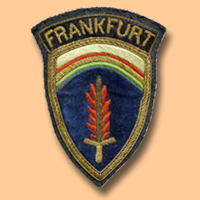 Frankfurt Post (?)
Frankfurt Post (?) |
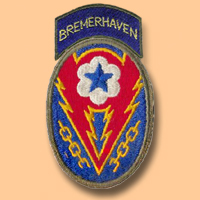
Bremerhaven POE (?)
|
|
|
|
|
|
| List
of Military Posts (as of 31 Dec 1948) |
|
|
|
|
|
| 7809 Station Complement Unit (Heidelberg Military Post) |
|
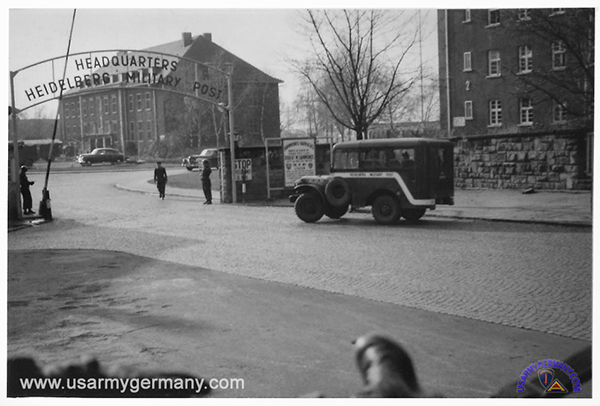
A military shuttle bus arrives at the Hammonds Barracks main gate (Michael Adel) |
|
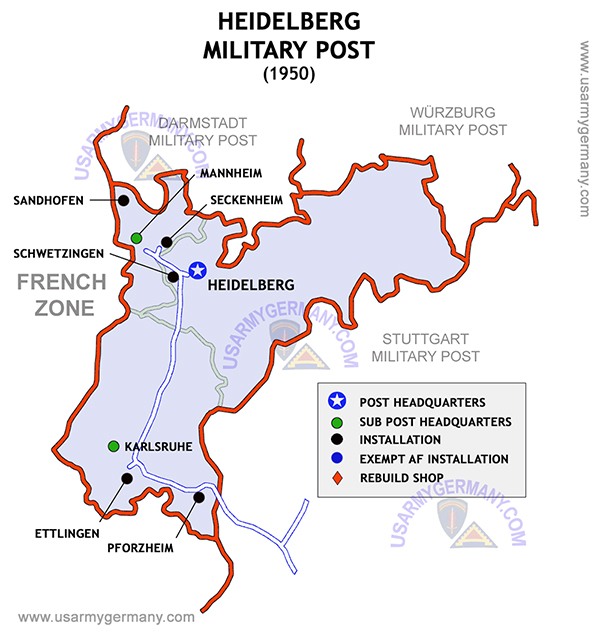
Heidelberg Military Post area map, 1950 (Walter Elkins) |
|
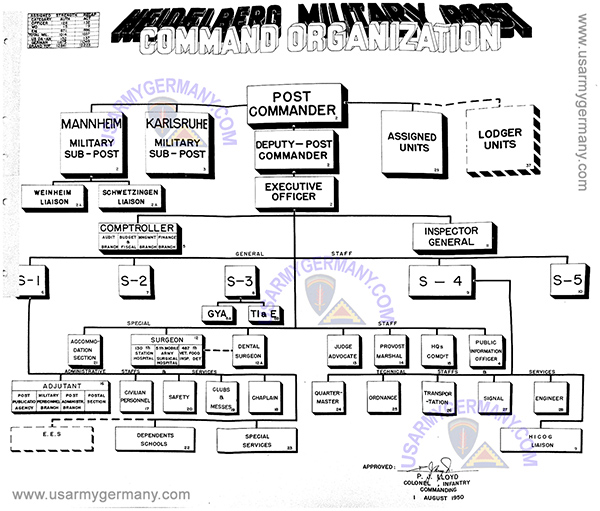
Heidelberg Military Post command organization, 1950 (Walter Elkins) |
|
| (Source: A photo book of the 7809 SCU, May 1949, submitted by Paula Moriarty, daughter of Paul L. Maiden, 7809 SCU) |
7809 SCU
Heidelberg Mil Post |
|
|
|
|
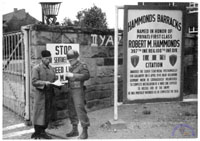
1. Main Gate, Hammonds Bks (KB)
|
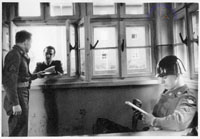
2. Guard house (KB)
|
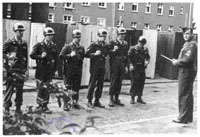
3. (KB)
|
|
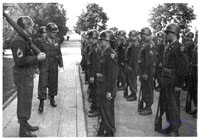
4. (KB) |
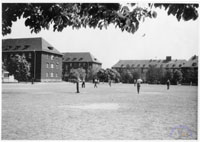
5. Baseball game on the parade field (KB) |
|
|
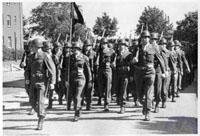
6. (KB)
|
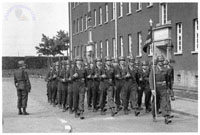
7. (KB) |
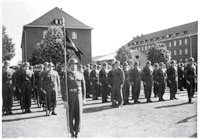
8. (KB) |
|
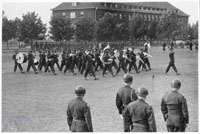
9. (KB)
|
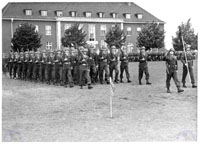
10. (KB) |
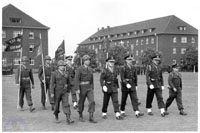
11. (KB) |
|
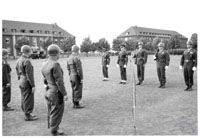
12. (KB)
|
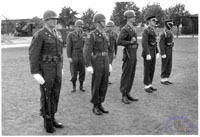
13. (KB) |
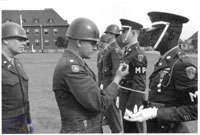
14. (KB) |
|
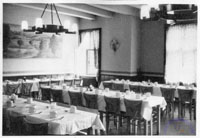
16. Dining hall (KB)
|
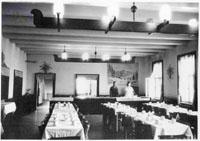
17. Dining hall (KB) |
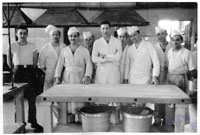
18. Kitchen (KB) |
|
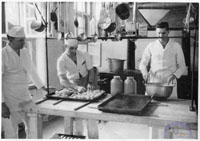
19. Kitchen (KB)
|
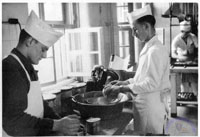
20. Kitchen (KB) |
|
|
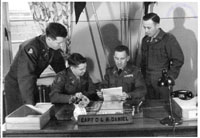
21. Capt. D.L. McDaniel, CO (KB)
|
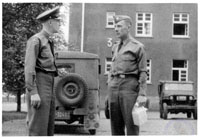
22. Co and another officer in discussion (KB) |
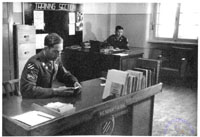
23. Training Section (KB) |
|
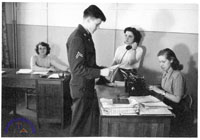
24. Admin office (KB)
|
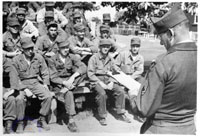
25. (KB) |
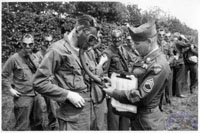
26. (KB) |
|
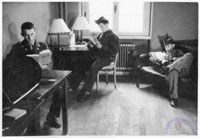
27. Day room (KB)
|
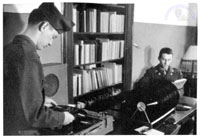
28. Day room (KB) |
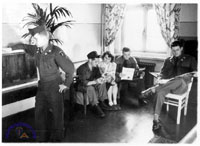
29. Day room (KB) |
|
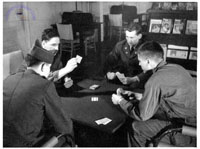
30. (KB)
|
|
|
|
|
|
|
| 7811 Station Complement Unit (Frankfurt Military Post) |
|
|
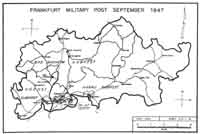 FMP, Sept 1947
FMP, Sept 1947
|
|
|
|
|
7811 SCU
Frankfurt Mil Post |
|
|
|
|
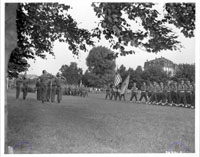
1. 7811 SCU, 1950 (KB)
|

|
|
|
|
|
|
| 7812 Station Complement Unit (Rhine Military Post) |
|
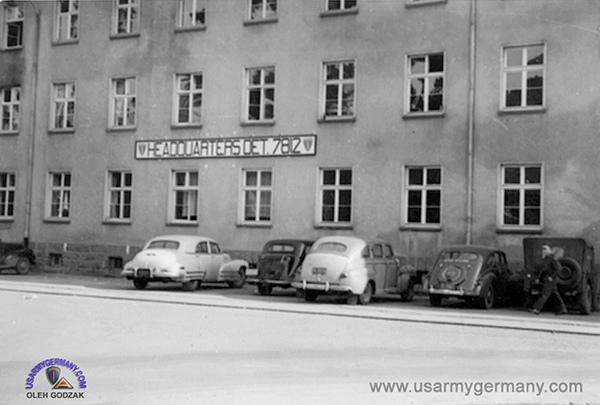
7812th SCU building at Panzer Kaserne, Kaiserlsautern, 1950 (Oleh Godzak)
|
|
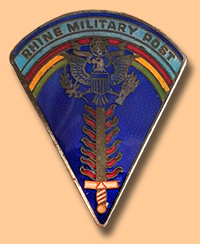 Rhine Military Post DUI Rhine Military Post DUI |
|
|
 |
|
|
| Army
Education Centers in Germany |
|
| (Source: Email
from Mike Scott, son of Dr. Ralph Scott) |
My late father,
Dr. Ralph W. Scott, ran the Augsburg Military Post
Army Education Center during the years 1948-1949; he helped
get the University of Maryland's classes organized and started; got
promoted to run the much larger Frankfurt Military
Post Army Education Center in 1949, where he remained during
the tenure of General Green, HQS EUCOM.
He was promoted to the Pentagon in 1951, to run the Army's worldwide
education program. He appeared on the Army-sponsored "Big Picture"
black-and-white TV show which appeared locally in the Washington,
D.C. area on the Dumont Television Network (Channel 5) during the
1952 and 1953 period. (I watched Dad on our TV set at home, on many
Saturday mornings. He looked great, just like he did in person!!!)
I have a photo of him at the Pentagon, surrounded by Army colonels
and I believe at least one general. Dad had quite a background --
PHD from Columbia; Masters from Princeton; another Masters from Kings
College at Nova Scotia; and still another one, from the University
of Paris, France.
During the war, he helped direct the strategic bombing of Japan while
assigned to the OSS. (He had been Chairman of the Department of Foreign
Languages at St. Paul's University known in Japanese as the Rikkyo
Imperial University, where he taught for ten years, from 1930 to 1940.
(He appeared in "Who's Who in Japan, 1930-1940") so he was very famailiar
with where the right targets were !!!.
The Army was really instrumental in education at least two generations
of young men who so valiantly and unselfishly served their country.
Through the Army, they often graduated from high school through the
Army's GED testing program. Then it was on to four years of college,
thanks to the University of Maryland and other great American educational
institutions. The result: All of this helped -- literally -- educate
America for the future role it was to have as a true, "Superpower".
When Dad retired in the spring of 1961, at age 70, as a GS-14 (in
those days, that grade was considered very high-ranking for a civilian
advisor for the Department of the Army), he got quite a nice Letter
of Commendation signed by the Adjutant General of the United States
Army, for all he had done to help educate the "Backbone of the Nation's
Defense" -- the soldier.
And another historical note: General Pearce (Or was it, "Pierce"?)
was Commander of the Augsburg Military Post. (In the year 1948).
Dad's asssociates/fellow staff members: A little bit sketchy as to
spelling (for a barely-teenager at the time) but here goes: COL Louis
Strehlow, US Army, at the Pentagon (He worked closely with Dad. Time
frame: 1950s to about 1961.) Mr. O'Mara, who assisted Dad in Frankfurt.
(That's the way the name sounded -- it could have been, "Omeara" --
but people who knew him, would remember. Mr. Donald Piper, at the
Augsburg Army Education Center. Later, in fact many years later, Piper
became U.S. Agricultural Attache to the Republic of Vietnam, in Saigon
(This was of course before the Vietnam War.) The jeep he was riding
in, was involved in an accident; and Piper was seriously injured (His
skull was crushed in at one point, and he had a silver plate installed
to try and repair his skull.) We heard following this accident, that
he became a Chief of Agriculture for the State of Maine. Don was a
very, very fine person, and like Dad, represented the Department of
the Army with great credit to himself. He was married, and had two
sons, both born in about 1948 when he was in Augsburg.
There was an organizational change in the Pentagon during the years
Dad was the Chief Education Advisor to the Department of the Army:
When we left Frankfurt and returned to the States in the summer of
1951, Dad was asssigned to the Office of the Chief of Staff of the
Army at the Pentagon. Years later, Dad's office was moved to the Office
of the Adjutant General of the Army. (This, our family thought at
the time, made more sense, because the role of education of the Army's
personnel, could better be supported and maintained there, since Education,
though considered highly important to the efficiency of the Army in
the retention of better-educated personnel, was not a combat related
function.)
I was enlisted, but a darn good soldier. I was awarded recognition
by my Commander, Maj. Heinz Just, CO, as "Soldier of the Month" for
March 1962. I was a US Army Reservist for six years; got called up
by then-President Kennedy; was assigned to the 223rd Military Intelligence
Detachment and we were attached to the 32nd Infantry Division (Red
Arrow). The reason for the callup: Construction of the Berlin Wall
in the late summer of 1961. When the Reserves were demobilized and
sent home, I received a Letter of Appreciation from then-Secretrary
of the Army Cyrus Vance.
Mike Scott |
 |
|
|
| US
Forces in Germany POV License Plates |
|
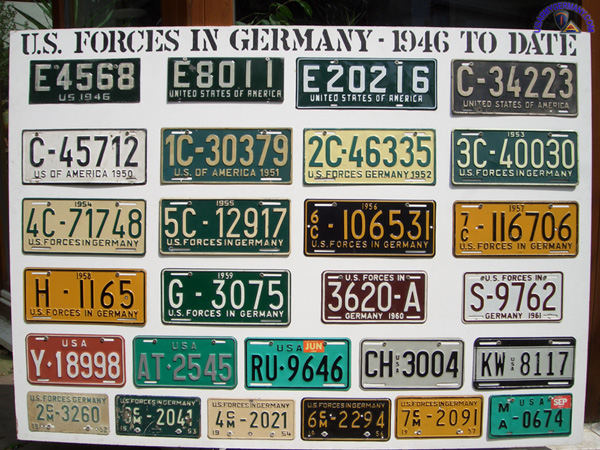
Display created by Mike Montgomery, collector and expert
|
|
| Some comments from Mike: The "To Date" label needs to be changed to read "Thru 2009" since the intent is that all USA/NATO Star plates will be replaced by German plates end of this year. Then I'll need to substitute the motorcycle plates along the bottom of the display with the last of the series - the USA/NATO Star plates. You can go ahead and add the display and when I finally get around to making the update, you can substitute it. |
|
|
| (Source: Images
of several of the older plates are courtesy Mike Montgomery, HQ USAREUR
ODCSENGR and 18 EN BDE) |

1.
1946/47 (1)
|

2. 1946/47
(2)
|

3. 1946/47
(3)
|
|

4.
1948/49
|

5.
1950
|

6. 1951
|
|

7. 1952 |

8. 1953 |

9. 1954 |
|

10. 1955 |

11. 1956 |

12. 1957
|
|

13. 1958
|

14. 1959
|
|
|

15. 1960
|

16. 1961
|

17. 1962
- 1965 |
|

18. Jan
1966 - Nov 1972 |

19. Dec
1972 - May 1982 |

20. June
1982 - Jan 1990 |
|

21. Feb 1990 - 2002 |
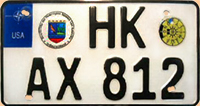
22. July 2000 - present day |
|
|
|
(1) A
license plate from the first series (Note: the "E" prefix
stands for ETO)
(2) A license plate from the second series (the serial numbers
picked up where they left off on the first issue)
(3) An example from the third and last of the series (began
with serial # E10000) |
|
| |
| (Source: Information courtesy Mike Montgomery, HQ USAREUR ODCSENGR and 18 EN BDE) |
The L-583 below is an early issue plate.
I've seen 2-digit serials on these as well, but as a former RMV employee
told me, it wasn't long before they realized the system was getting out
of hand.
I'll use this "L" plate as an example: In 1962, when this plate
was first introduced (as the first aluminum plate, and the first
multi-year plate in the US Forces Germany POV plates, by the way), the
idea was to assign plates by location; hence the letter prefix. In some
cases, the military population in a particular location was small, so
the RMV divided the serials over two or more locations. In the case of
"L", plates with serials L-1 thru L-3800 were reserved for folks
stationed at Bitburg Airbase; L-3801 thru L-6400 plates were reserved
for folks assigned to Spandahlem Airbase.
As time went along, it was
discovered that the number of plates required for some locations
exceeded the serial allocated! So they "borrowed" serials from other
locations. To compound the problem, my friend tells me, the policy was
that if a servicemember got reassigned to another duty location (in
Germany) he had to report to the local RMV Field Office at his new
location and turn in his plates from his previous duty location, in
exchange for new plates for his new location! The old plates then had
to be returned to the RMV at the old duty location! What an
accountability nightmare!
So in 1966 the RMV came out with the
silver-on-green plates havining a two-letter, four-digit serial number,
beginning with AA-0100. The prefixes generally had no meaning, so they
could be used anywhere in Germany. Much simpler solution, I must say.
I've added as an attachment the original listing of the plate prefixes
used from 1962 thru 1965. Note that the concept was carried over from
1958, when the RMV first began using these letter prefixes, varying only
in 1960 when the letter was incorporated in the serial as a suffix. |
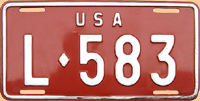
1. Bitburg AB
|

2. Nuernberg
|
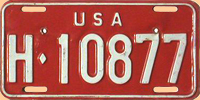
3. ????
|
|
|
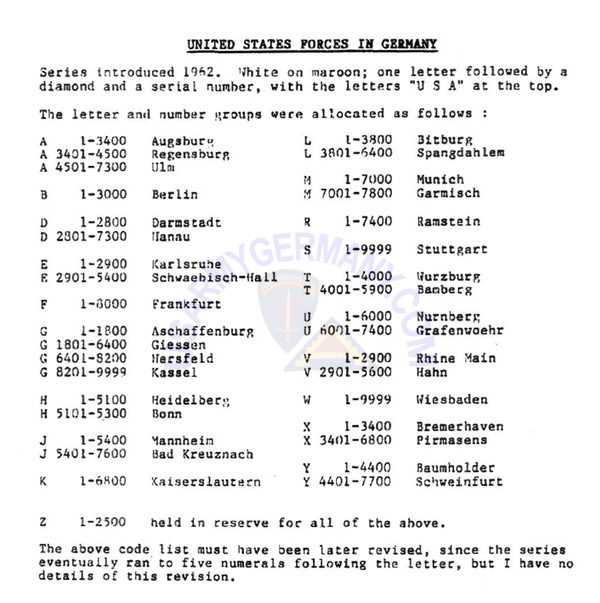 |
 |
|
| |
| US
Mission (HICOG) in Germany License Plates |
|
| (Source: Images
are courtesy Mike Montgomery, HQ USAREUR ODCSENGR and 18 EN BDE) |
|
|
|
| |
| US Forces in Austria License Plates |
|
| (Source: Images are courtesy Mike Montgomery, HQ USAREUR ODCSENGR and 18 EN BDE) |

1. 1950-51 (1) |

2. 1952-53 |

3. 1954
|
|

4. 1955 (2) |
|
|
|
|
(1) Prior to 1950, the US Forces in Austria apparently used the same plates as our forces in Germany were using. I haven't found this in writing yet, but from a number of dated photos from the time (see Dr. Prigl's photos on www.usfava.com), it would appear this was the case. (Images 1, 2 and 3 in the US Forces in Germany section from the 1946-47 series, and Image 4 from the 1948-49 series).
(2) US Forces left Austria in 1955 after the signing of the Austrian Peace Treaty. |
|
| |
| Other US Forces in Austria License Plates |
|
| (Source: Images are courtesy Mike Montgomery, HQ USAREUR ODCSENGR and 18 EN BDE) |

1. 1951 (1) |

2. 1954 (2) |
|
|
|
(1)
Sample of the plates used on official, military vehicles.
The first example of an exclusively USFA plate for military vehicles was white numbers on a red background, having the legend "USFA 1950" at the bottom. (I believe Bill Billet, US Forces in Austria Veterans Assn., has one of these on his jeep; the serial starts with the letter J. I've added the 1951 version of that plate as photo #1 above, red numbers on a white background. It would have been for a Staff car, and with the low serial number (S-6) I'm presuming it was for someone important! In 1953 they reversed the colors once again (back to white-on-red), but left off the date, just the legend USFA at the bottom -- they apparently retained this plate until we pulled out in 1955. At about the same time (1952) the US Army in Germany did the same thing with its military vehicle plates series -- before that, the legend changed each year, alternating from top to bottom, e.g., "US ARMY 46" (see photo 1046_US_Army below) but in 1952/3 you see plates with just "US ARMY" at the bottom:
(2) Image #2 is a plate issued to State Dept personnel assigned to the US Mission (predecessor to the Embassy) in 1954. Similar to the US Mission - Germany HICOG plates shown above. |
|
| |
| Military License Plates |
|
| (Source: Images are courtesy Mike Montgomery, HQ USAREUR ODCSENGR and 18 EN BDE) |

1. 1946 (1) |
|
|
|
|
"T" . . . truck
"S" . . . sedan
"J" . . . jeep |
| |
| (Source: Email from Mike Montgomery, HQ USAREUR ODCSENGR and 18 EN BDE) |
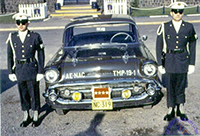 NACom staff car with "NC" prefix on license plates
NACom staff car with "NC" prefix on license plates
|
|
That photo is really a classic, especially since it's in color. Those black-on-yellow plates were issued for use on specific official military vehicles (primarily sedans) from the 1950s up until around 1973 or so. I remember them, but it was before I was really interested in collecting military plates, so I missed some golden opportunities to perhaps pick up a few. Yes, with 4 stars the "passenger" must have been a high roller!
The so-called Area Commands preceded the "support districts." When I was stationed in Germany as a LT (1970-72) in Kaiserslautern, we were working in what was referred to as the Rheinland-Pfalz Support District. When I returned in 1975, the old signs were still up but earlier that year they had changed over and we were under the 1st Support Brigade (which was transplanted from Mannheim) and quickly that became the 21st Support Command (needed "command" status in order to justify a 2-star general so the Army would be on equal footing with the Air Force (Ramstein) in the Kaiserslautern or K-town area! Oh, the wonders of the military! |
|
|
The predecessor to the Rheinland-Pfalz Support District was the Western Area Command, and some of the old timers still there when I arrived in 1970 recalled the days of that command. I suspect (without cheating and looking at your website) that the Northern Area Command was home-based somewhere north of Frankfurt. Doubt that it would have been Bremerhaven since they had their own status. But I'll check the site after I send this to you.
Other plates from this era include those with prefixes of: EC (European Command or EUCOM, in Stuttgart), TA (TASCOM, in Worms), CZ (COMMZ, in Zweibruecken), 5C (5th Corps, in Frankfurt), 7C (7th Corps in Stuttgart), and BC (Berlin Command). The only ones still on the road are those used by AAFES (EX prefix), and only the vehicles (long-haul trucks and some staff cars) in Giessen Depot still use the black-on-yellow plates; all other AAFES vehicles have switched to a black-on-white color scheme. The last of these to be phased out (not counting the majority of AAFES plates) was the Berlin Command series, which ended when we pulled out of Berlin in 1994. Unfortunately I was unable to get up there and spend some quality time scoffing up plates, so those I do have were acquired off of German eBay.
All these plates have the legend US FORCES at the top, and have as few as one number serials. I have a BC-13 plate, and I've seen photos of single digit serials. AAFES plates typically have four digits. |
|
| |
| Official Road
Maps for Allied Forces, Europe |
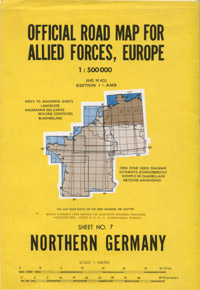
Northern Germany |
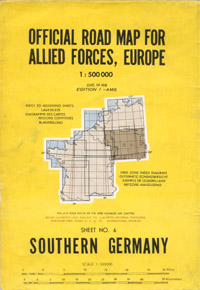
Southern Germany |
Maps
used by USAREUR motorists in the 1950s; prepared by the USAREUR
Engineer Intelligence Center.
Maps
were copied in 1953 from the Deutsche Shell maps
|
|
|
|
| |
(Source: John
deTreville)
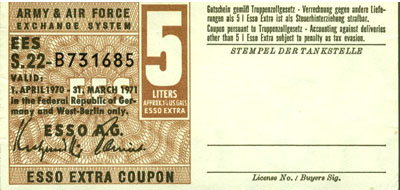
Esso Gas Coupon
issued in 1970 |
| |
 |
| |
|
 1st Military District DUI
1st Military District DUI  2nd Military District Patch w/ Tab (can anybody confirm accuracy?)
2nd Military District Patch w/ Tab (can anybody confirm accuracy?)  Click on
map to view map of Landkreise of the US Zone of Occupation
Click on
map to view map of Landkreise of the US Zone of Occupation Click on
map to view USFET Military Posts (US Zone only)
Click on
map to view USFET Military Posts (US Zone only) 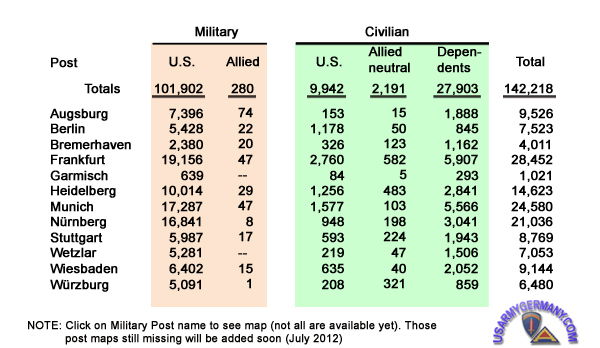
 Rhine Military Post DUI
Rhine Military Post DUI


